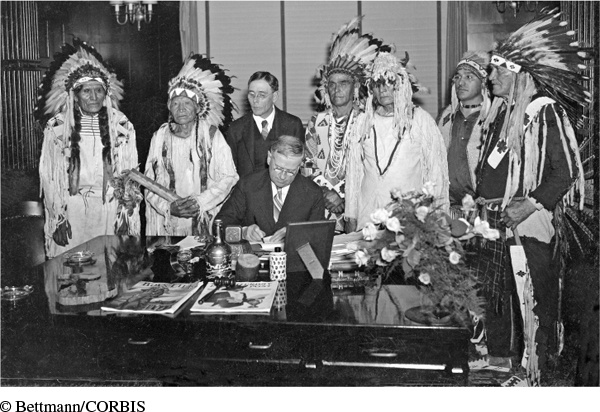A Half Deal for Minorities
President Roosevelt made significant gestures on behalf of African Americans. He appointed Mary McLeod Bethune and Robert Weaver to staff New Deal agencies and gathered an informal “Black Cabinet” in the nation’s capital to advise him on matters pertaining to race. The Roosevelt administration also established the Civil Liberties Unit (later renamed Civil Rights Section) in the Department of Justice, which investigated racial discrimination. Eleanor Roosevelt acted as a visible symbol of the White House’s concern with the plight of blacks. In 1939 Eleanor Roosevelt quit the Daughters of the American Revolution, a women’s organization, when it refused to allow black singer Marian Anderson to hold a concert in Constitution Hall in Washington, D.C. Instead, the First Lady brought Anderson to sing on the steps of the Lincoln Memorial.
Perhaps the greatest measure of Franklin Roosevelt’s impact on African Americans came when large numbers of black voters switched from the Republican to the Democratic Party in 1936, a pattern that has lasted to the present day. “Go turn Lincoln’s picture to the wall,” a black observer commented after the election. “That debt has been paid in full.”
Yet overall the New Deal did little to break down racial inequality. President Roosevelt believed that the plight of African Americans would improve, along with that of all downtrodden Americans, as New Deal measures restored economic health. Black leaders disagreed. They argued that the NRA’s initials stood for “Negroes Ruined Again” because the agency displaced black workers and approved lower wages for blacks than for whites. The AAA dislodged black sharecroppers. New Deal programs such as the CCC and those for building public housing maintained existing patterns of segregation. Both the Social Security Act and the Fair Labor Standards Act omitted from coverage jobs that black Americans were most likely to hold. In fact, the New Deal’s big labor/
This pattern of halfway reform persisted for other minorities. Since the end of the Indian wars in 1890, Native Americans had lived in poverty, forced onto reservations where they were offered few economic opportunities and where whites carried out a relentless assault on their culture. By the early 1930s, American Indians earned an average income of less than $50 a year—compared with $800 for whites—and their unemployment rate was three times higher than that of white Americans. For the most part, they lived on lands that whites had given up on as unsuitable for farming or mining. The policy of assimilation established by the Dawes Act of 1887 had exacerbated the problem by depriving Indians of their cultural identities as well as their economic livelihoods. In 1934 the federal government reversed its course. Spurred on by John Collier, the commissioner of Indian affairs, Congress passed the Indian Reorganization Act (IRA), which terminated the Dawes Act, authorized self-government for those living on reservations, extended tribal landholdings, and pledged to uphold native customs and language.

Although the IRA brought economic and social improvements for Native Americans, many problems remained. Despite his considerable efforts, Collier approached Indian affairs from the top down. One historian remarked that Collier had “the zeal of a crusader who knew better than the Indians what was good for them.” The Indian commissioner failed to appreciate the diversity of native tribes and administered laws that contradicted Native American political and economic practices. For example, the IRA required the tribes to operate by majority rule, whereas many of them reached decisions through consensus, which respected the views of the minority. Although 174 tribes accepted the IRA, 78 tribes, including the Seneca, Crow, and Navajo, rejected it.
Exploring American HistoriesPrinted Page 742
Exploring American Histories Value EditionPrinted Page 547
Chapter Timeline